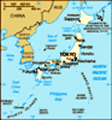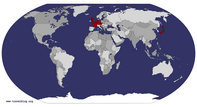Advertisement
It was rainy and windy at night of 24
th April. The weather forecasts on the TV said that the weather would be changed and the temperature would plummet all over in Japan from 25
th April: like Britain, the weather is changeable in spring in Japan. Looking at the weather in Hagi, it would remain cloudy but the temperature would drop to 17 degree.
On 25
th April – we planned visiting west and south part of Hagi; we were to catch the westbound bus called ‘Shinsaku-kun’ from outside of our hotel. There was a Western-looking couple at the bus stop. They got on the same bus and seemed to be struggling to find out the ways to get by (there wasn’t very much English information on the bus). One of them had noticed that I was speaking to Mark in English and asked me for help. He said that he would go to Hagi Castle and visit other sightseeing places. I suggested him that they would buy one-day bus pass, and helped them buy the tickets when the bus stopped at Hagi Castle. We continued travelling with the westbound bus and got off at Hagi
Castle Ruins/entrance of Shizuki Koen.
Hagi Castle Ruins/Shizuki Koen (Park) We walked past the river, the quay for the sightseeing boats, the youth hostel, the Former Asamori Residence, Car Park and Pottery Museum on the way to Shizuki Koen. After crossing over the inner moat, we arrived at the entrance for the park and were asked to pay ¥210 for the entry. The entry fee was combined with the entry to Asamori Residence.
Despite its large castle and it was still in good condition, Hagi Castle was demolished soon after Meiji Restoration. We could only see the base where Tenshukaku (the five-storey castle) stood from the entrance. We approached the base and saw ruins of the castle’s adjacent buildings behind the Tenshukaku.
We continued walking on the park, crossed over the arched bridge and walked up to the shrine. There were a number of people who were sweeping leaves on the ground. Their job was frugal but very helpful for tourists and helped to prevent them trip over the steps and the landing around the shrine.
As we walked down, we
found the tea house, which was originally a part of Mori Clan’s villa, and was transferred to the present place at the beginning of the 1910s.
We tried to climb up Shizukiyama Mountain on the back of the park. The footpath was designed for climbers to walk up to the summit and flanked by overgrown bushes. Because of the previous night’s wet weather, the footpath was quite slippery and getting steeper as we climbed up. We were also told that there would be limited views from the top; so we decided not to climb to the top. I recall that we managed to do this trekking up the half of 143 metre mountain course.
After having a little rest, we strolled through the pond garden on the east of the park. There were a number of turtles and ducks and waterfowls swimming and it offered a tranquil environment.
After that, we looked at the white wall with little rectangular holes: this is where the defence army placed rifles to protect the castle. This wall was restored in 1965, and together with the shrine, this wall was used for the long period

 East garden
East garden
home to turtles and Koidrama series, ‘Hana no Yu’ recently.
Upon leaving Hagi Castle Ruins, we popped in the shop adjacent to Pottery Museum. There were a lot of distinctive, decorative and ornate pieces of pottery on sale; were all good and highly priced. I heard some Western people were arguing these prices. These items were quite cumbersome and hard to carry to their homes: buyers would take a lot of consideration when purchasing these items.
Former Asamori Clan Residence We visited former Asamori Hagi Yashiki Nagara building. Asamori family was one of the wealthiest family and possessed a really big house in Edo period, but the big residence was demolished after the Meiji Restoration and only Nagaya (a long wing of the building containing several divided rooms) remained. It is one of the longest Nagaya buildings in Hagi and was designed for the Tangible Cultural Property in 1966. At one of the exhibition rooms of Asamori Clan Residence, we saw the model of Hagi Castle including Tenshukaku Castle. It was interesting to learn that the castle’s
buildings stretched to the top of Shizukiyama Mountain.
It was lunch time when we finished looking round Former Asamori Clan Residence. We entered one of the souvenir shops containing restaurants near the Car Park. I was told that the restaurant staff were not able to serve a lot of dishes displayed on the window because of the shortage of staff: the restaurant owner allowed his staff to take days off before a ten day constructive holiday between 28
th April and 7
th May. The restaurant was quiet on 25
th April; we ordered udon noodle with beef.
Hagi Sightseeing Boat We were both interested in riding on the sightseeing boat. It was cloudy and rather chilly in the early afternoon; we were the only passengers at that time. However, this offered a great benefit for us: we were offered to sit at the front of the boat so that we were fully able to see historic buildings and attractions along the river while the driver was giving commentary.
After leaving Shizukibashi Bridge, the driver steered down to Hashimotogawa River, showed us historic
buildings, e.g. Kuchiba Residence in the high rank samurai’s district. He explained to us about Hagi’s speciality, summer oranges: they get ripened at the beginning of May, otherwise they may be too sour, but they can be processed as marmalade jams, orange juices, salad dressing and ice creams. Pointing at boats on the bank of Tamae’s side, he explained that there is an annual event of boat races in June.
We were asked to wear ‘life jackets’ when getting on the boat, as I guessed that sightseeing boat course includes the sea and it is a safety precaution. After coming back from the river, the driver took us to the sea and showed us the wall and Hagi Castle Ruins and Shizukiyama Mountain. It was interesting to see these buildings and the mountain from the different angle. The sea was choppy at that time; it was a job for us to keep our balance whilst taking photos.
After getting off the boat, we briskly walked to Kuchiba Residence along the river. This upper class samurai residence had thick plaster walls and the ornate tile. The Nagayamon gate had the plaster
wall. This house possessed a guard station, a stable and an extra room. I was told that descendants of Kuchiba family still live in the back of this house. We enjoyed seeing the stunning Japanese garden and beautiful scenery of Hashimoto River and the opposite bank of Tamae district.
Next, we headed for Horiuchi Kaimagari. Horiuch district was resided by Mori Clan’s family and upper class samurai’s families and it is a preserved district. Horiuchi Kaimagari is a labyrinthine street with right angled corners. The street was flanked by high walls, consisting of mud wall on top of coarse stone bases and featured right angled corners – was designed for the security purposes and helped to chase and catch intruders. We could see citrus trees above mud walls.
The historic street led us to the historic bridge, Heianbashi Bridge. This arch-stone bridge was one of three routes constructed over the outer moat connecting from the upper samurai district to the castle district – and it one of the remaining bridges from Edo period. I found the westbound bus was coming at Hisasaka Shigemizu’s birthplace at 14.22

 Quay
Quay
We were asked to wear life jackets as the boat course includes seaand took the bus for Daishōin.
Daishōin Temple Daishōin Temple was located on the middle of the hilly wood, south of the town centre; so we had to walk uphill a bit from the bus stop. It was worth travelling to the temple in the rural district of Hagi. We admired the beautiful wooden gate, Toromon (designated as a Tangible National Property), the main hall surrounded by Zen Garden and were amazed at loads of lanterns leading to the graves of daimyo (feudal lords) in the succession of the Mori Clan lords who were buried. I heard that these lanterns are lit during Obon period, mid August in Hagi.
Aiba Canal District It was 3.30 when we finished strolling around Daishōin Temple; I found we could amble through the traditional residential houses and historic houses of Katsura Tato and Former Yukawa Residence along Aiba Canal. After getting off the bus, we soon found the sign for these historic houses. Like pictures in the guide book, houses and watercourse offered picturesque scenes together with tranquil environment.
The peaceful
canal walk led us to two historic houses: Former Katsura Taro’s house and Former Yukawa Residence. Katsura Taro was appointed as the prime minister three times since Meiji Restoration. This house possessed a beautiful water garden with the statue of himself, a little brook which took water from Aiba Canal, pine trees and camellias and cherry trees.
Our final destination was Former Yukawa Residence. Living at the top upstream of Aiba Canal, the Clan was responsible for checking the water level at all time.
Aibagawa is a canal flowing southeast of Hagi’s former castle town and was constructed at the beginning of the 18
th century. It was used by small boats for transportation of goods and its water was used for farming and fire prevention. Today, colourful carps can be seen in place of the boats. The Former Yukawa House showed us how Aiba’s water was used in daily life: the washing are where residents used to wash tableware and vegetables using water from the river; the bathing area which has the system where dirty water was filtered before its water flowed back to the canal. At the washing area, I could see the

 Daishoin
Daishoin
Another graveyard which made native British man amazed. wooden blind which provided residents privacy.
All these historic houses had helpful volunteer guides who helped us learn about the history of the property and residents and celebrities who lived in the past and general features of the houses.
Afterwards, we went back to the bus stop and caught the bus back to our hotel. There were a wide range of souvenirs sold in the gift shop on the ground floor of Hagi Grand Tenku Hotel. I bought a pair of the pottery for my parents and sweets for my work colleagues and coasters and postcards for ourselves.
Advertisement
Tot: 0.101s; Tpl: 0.014s; cc: 11; qc: 24; dbt: 0.0305s; 1; m:domysql w:travelblog (10.17.0.13); sld: 1;
; mem: 1.1mb













